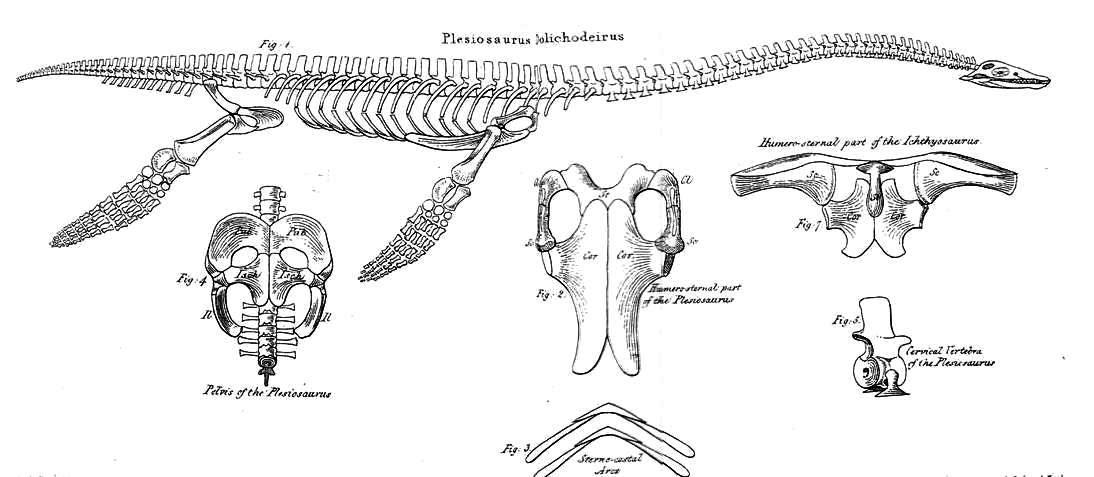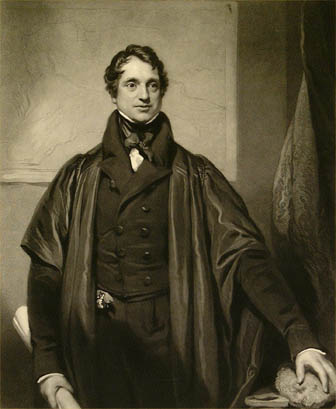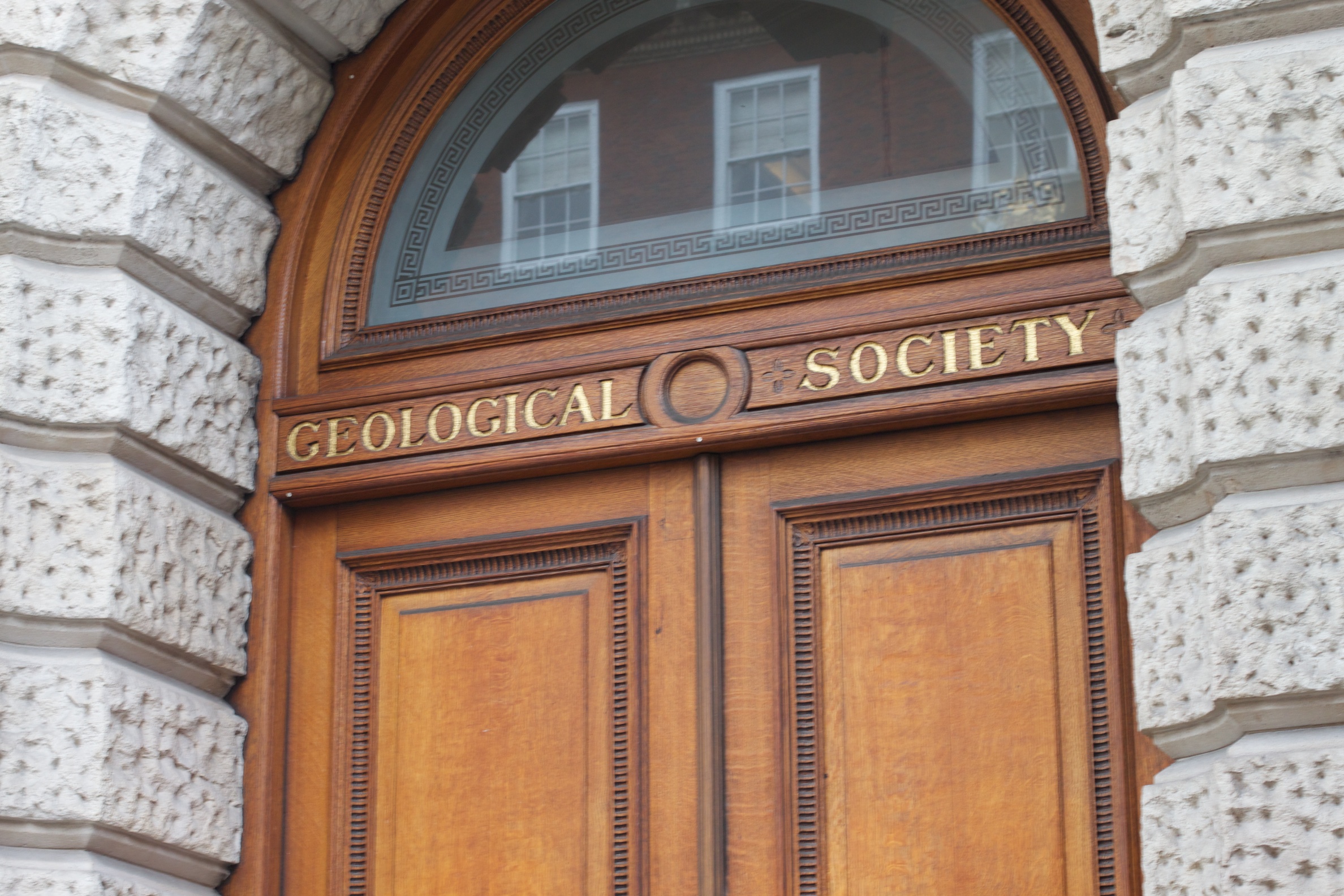|
William Daniel Conybeare
William Daniel Conybeare FRS (7 June 178712 August 1857), dean of Llandaff, was an English geologist, palaeontologist and clergyman. He is probably best known for his ground-breaking work on fossils and excavation in the 1820s, including important papers for the Geological Society of London on ichthyosaur anatomy and the first published scientific description of a plesiosaur. Life and career Childhood and education He was a grandson of John Conybeare, bishop of Bristol (1692–1755), a notable preacher and divine, and son of Dr William Conybeare, rector of St Botolph-without-Bishopsgate. Born in London, he was educated there at Westminster School, then went in 1805 to Christ Church, Oxford, where in 1808 he took his degree of BA, with a first in classics and second in mathematics, and proceeded to MA three years later. Early career Having entered holy orders he became in 1814 curate of Wardington, near Banbury, and he accepted also a lectureship at Brislington near Bris ... [...More Info...] [...Related Items...] OR: [Wikipedia] [Google] [Baidu] |
Itchen Stoke
Itchen Stoke and Ovington () is an English civil parish consisting of two adjoining villages in Hampshire, England, west of New Alresford, Alresford town centre in the valley of the River Itchen, Hampshire, River Itchen, north-east of Winchester, and south-east of Itchen Abbas. Itchen Stoke The village population is 210, including Abbotstone. Its most notable building is the St Mary's Church, Itchen Stoke, Church of St Mary, a redundant Anglican church built by the civil engineer and architect Henry Conybeare in 1856, now under the care of the Churches Conservation Trust. It is in an early French style, Grade II* listed and made of brown and grey rubble stone with limestone dressings. History The manor of Itchen Stoke was granted to the Bishop of Winchester by Edgar the Peaceful, King Edgar in 960. The Domesday Book records the manor as having passed to Romsey Abbey, which retained it until the Dissolution of the Monasteries. It then passed to William Paulet, 1st Marquess of W ... [...More Info...] [...Related Items...] OR: [Wikipedia] [Google] [Baidu] |
Master's Degree
A master's degree (from Latin ) is a postgraduate academic degree awarded by universities or colleges upon completion of a course of study demonstrating mastery or a high-order overview of a specific field of study or area of professional practice. A master's degree normally requires previous study at the bachelor's degree, bachelor's level, either as a separate degree or as part of an integrated course. Within the area studied, master's graduates are expected to possess advanced knowledge of a specialized body of theoretical and applied topics; high order skills in analysis [...More Info...] [...Related Items...] OR: [Wikipedia] [Google] [Baidu] |
Conybeare Plesiosaur 1824
Conybeare or Coneybeare is a surname. Notable people with the surname include: * Catherine Conybeare (born 1966), American philologist * Charles Conybeare (other), multiple people * Chris Conybeare, Australian public servant * Florence Annie Conybeare (1872–1916), British suffragist * Frederick Cornwallis Conybeare (1856–1924), British orientalist * Henry Conybeare (1823–1892), British civil engineer and architect * John Conybeare (1692–1755), British prelate and theologian * John Josias Conybeare (1779–1824), British scholar *John Josias Conybeare (1888–1967), English doctor, author of '' Conybeare's Textbook of Medicine'' * L. Ted Coneybeare (1925–2012), Canadian television producer * Rod Coneybeare (1930–2019), Canadian puppeteer, voice actor, and author * William Conybeare (other), multiple people {{surname, Conybeare ... [...More Info...] [...Related Items...] OR: [Wikipedia] [Google] [Baidu] |
Adam Sedgwick
Adam Sedgwick FRS (; 22 March 1785 – 27 January 1873) was a British geologist and Anglican priest, one of the founders of modern geology. He proposed the Cambrian and Devonian period of the geological timescale. Based on work which he did on Welsh rock strata, he proposed the Cambrian period in 1835, in a joint publication in which Roderick Murchison also proposed the Silurian period. Later in 1840, to resolve what later became known as the Great Devonian Controversy about rocks near the boundary between the Silurian and Carboniferous periods, he and Murchison proposed the Devonian period. Though he had guided the young Charles Darwin in his early study of geology and continued to be on friendly terms, Sedgwick was an opponent of Darwin's theory of evolution by means of natural selection. He strongly opposed the admission of women to the University of Cambridge, in one conversation describing aspiring female students as "nasty forward minxes." Life and career Sedgwick ... [...More Info...] [...Related Items...] OR: [Wikipedia] [Google] [Baidu] |
William Buckland
William Buckland Doctor of Divinity, DD, Royal Society, FRS (12 March 1784 – 14 August 1856) was an English theologian, geologist and paleontology, palaeontologist. His work in the early 1820s proved that Kirkdale Cave in North Yorkshire had been a prehistoric hyena den, for which he was awarded the Copley Medal. It was praised as an example of how scientific analysis could reconstruct events in the distant past. He pioneered the use of fossilised Feces, faeces in reconstructing ecosystems, coining the term coprolites. Buckland also wrote the first full account of a fossil dinosaur, which he named ''Megalosaurus'' in 1824. Buckland followed the Gap creationism, Gap Theory in interpreting the biblical account of ''Genesis'' as two widely separated episodes of creation. It had emerged as a way to reconcile the scriptural account with discoveries in geology suggesting the earth was very old. Early in his career Buckland believed he had found evidence of the Deluge myth, bibli ... [...More Info...] [...Related Items...] OR: [Wikipedia] [Google] [Baidu] |
The Geological Society
The Geological Society of London, known commonly as the Geological Society, is a learned society based in the United Kingdom. It is the oldest national geological society in the world and the largest in Europe, with more than 12,000 Fellows. Fellows are entitled to the postnominal FGS (Fellow of the Geological Society), over 2,000 of whom are Chartered Geologists (CGeol). The Society is a registered charity, no. 210161. It is also a member of the Science Council, and is licensed to award Chartered Scientist to qualifying members. The mission of the society is: "Making geologists acquainted with each other, stimulating their zeal, inducing them to adopt one nomenclature, facilitating the communication of new facts and ascertaining what is known in their science and what remains to be discovered". History The Society was founded on 13 November 1807 at the Freemasons' Tavern, Great Queen Street, in the Covent Garden district of London. It was partly the outcome of a previous c ... [...More Info...] [...Related Items...] OR: [Wikipedia] [Google] [Baidu] |
John Kidd (chemist)
John Kidd (10 September 1775 – 7 September 1851) was an English physician, chemist and geologist who took a leading role in Oxford's "scientific awakening" in the early years of the nineteenth century. Biography Kidd was born in Westminster, the son of a naval officer, and was educated at Christ Church, Oxford. He became reader in chemistry at Oxford in 1801, and in 1803 was elected the first Aldrichian Professor of Chemistry. He then voluntarily gave courses of lectures on mineralogy and geology. These were delivered in the dark chambers under the Ashmolean Museum, where William Conybeare, William Buckland, Charles Daubeny and others gained their first lessons in geology. Kidd was a popular and instructive lecturer, and through his efforts the geological chair, first held by Buckland, was established. Kidd's two geological publications—his ''Outlines of Mineralogy'' (1809) and ''Geological Essay on the Imperfect Evidence in Support of a Theory of the Earth'' (1815)� ... [...More Info...] [...Related Items...] OR: [Wikipedia] [Google] [Baidu] |
Deanery
A deanery (or decanate) is an ecclesiastical entity in the Catholic Church, the Eastern Orthodox Church, the Anglican Communion, the Evangelical Church in Germany, and the Church of Norway. A deanery is either the jurisdiction or residence of a dean. Catholic usage In the Catholic Church, Can.374 §2 of the Code of Canon Law grants to bishops the possibility to join together several neighbouring parishes into special groups, such as ''vicariates forane'', or deaneries. Each deanery is headed by a vicar forane, also called a dean or archpriest, who is—according to the definition provided in canon 553—a priest appointed by the bishop after consultation with the priests exercising ministry in the deanery. Canon 555 defines the duties of a dean as:Vicars Forane (Cann. 553–555) from the |
Bampton Lecturer
The Bampton Lectures at the University of Oxford, England, were founded by a bequest of John Bampton. They have taken place since 1780. They were a series of annual lectures; since the turn of the 20th century they have sometimes been biennial. They continue to concentrate on Christian theological topics. It is a condition of the Bampton Bequest that the lectures are published by the lecturer; they have traditionally been published in book form, and recent ones are available as video recordings. On a number of occasions, notably at points during the 19th century, they attracted great interest and controversy. Lecturers (incomplete list) Links to the text of some of the lectures up to 1920 are available at the Project Canterbury Web site. 1780–1799 * 1780 – James Bandinel ''Eight Sermons preached before the University of Oxford'' * 1781 – Timothy Neve ''Eight Sermons preached before the University of Oxford'' * 1782 – Robert Holmes ''The Prophecies and Testimony of ... [...More Info...] [...Related Items...] OR: [Wikipedia] [Google] [Baidu] |
Axminster
Axminster is a market town and civil parishes in England, civil parish on the eastern border of the county of Devon in England. It is from the county town of Exeter. The town is built on a hill overlooking the River Axe, Devon, River Axe which heads towards the English Channel at Axmouth, and is in the East Devon local government district. At the 2001 census, it had a population of 5,626, increasing to 5,761 at the United Kingdom Census 2011, 2011 census. The town contains two electoral wards (town and rural) whose combined population is 7,110. The market (place), market is still held every Thursday. Axminster gave its name to a type of Axminster carpet, carpet. An Axminster-type power loom is capable of weaving high-quality carpets with many varying colours and patterns. While Axminster carpets are made in the town by Axminster Carpets, Axminster Carpets Ltd, this type of carpet is now manufactured all over the world as well. History The town dates back to the Celtic times ... [...More Info...] [...Related Items...] OR: [Wikipedia] [Google] [Baidu] |
Glamorganshire
Glamorgan (), or sometimes Glamorganshire ( or ), was one of the thirteen counties of Wales that existed from 1536 until their abolishment in 1974. It is located in the south of Wales. Originally an early medieval petty kingdom of varying boundaries known in Welsh as Morgannwg (or Glywysing), which was then invaded and taken over by the Normans as the Lordship of Glamorgan. The area that became known as Glamorgan was both a rural, pastoral area, and a conflict point between the Norman lords and the Welsh princes. It was defined by a large concentration of castles. After falling under English rule in the 16th century, Glamorgan became a more stable county, and exploited its natural resources to become an important part of the Industrial Revolution. Glamorgan was the most populous and industrialised county in Wales, and was once called the "crucible of the Industrial Revolution", as it contained the world centres of three metallurgical industries (iron, steel and copper) and ... [...More Info...] [...Related Items...] OR: [Wikipedia] [Google] [Baidu] |
Brislington
Brislington is an area in the south east of the city of Bristol, England. It is on the edge of Bristol and from Bath, Somerset, Bath. Brislington Brook runs through the area in the woodlands of Nightingale Valley and St Anne's Wood. Brislington formerly housed the ITV Wales & West, HTV West Studios on Bath Road, and this is situated next to the historic Arnos Vale Cemetery. Other notable landmarks include Brislington House and the 15th-century St Luke's Church, Brislington, St Luke's Church. During the 18th–19th century, Brislington was regarded as a picturesque country village and contained many country homes. For elections to Bristol City Council, the area is divided between Brislington East and Brislington West electoral wards. It is in Bristol East parliamentary constituency. History The parish of Brislington was historically part of the Keynsham (hundred), Keynsham Hundred (county subdivision), Hundred in Somerset. Brislington is also near to the site of the now demol ... [...More Info...] [...Related Items...] OR: [Wikipedia] [Google] [Baidu] |




